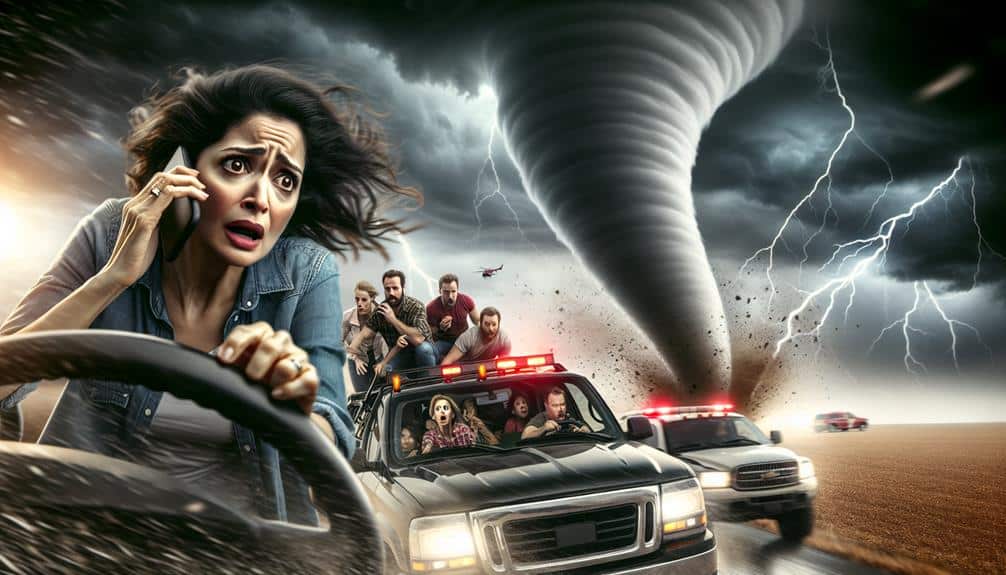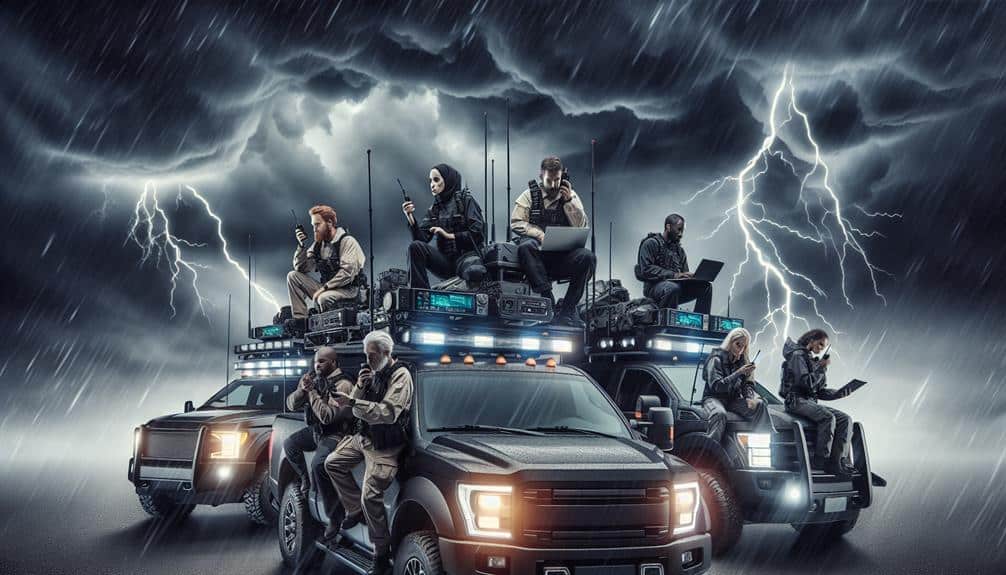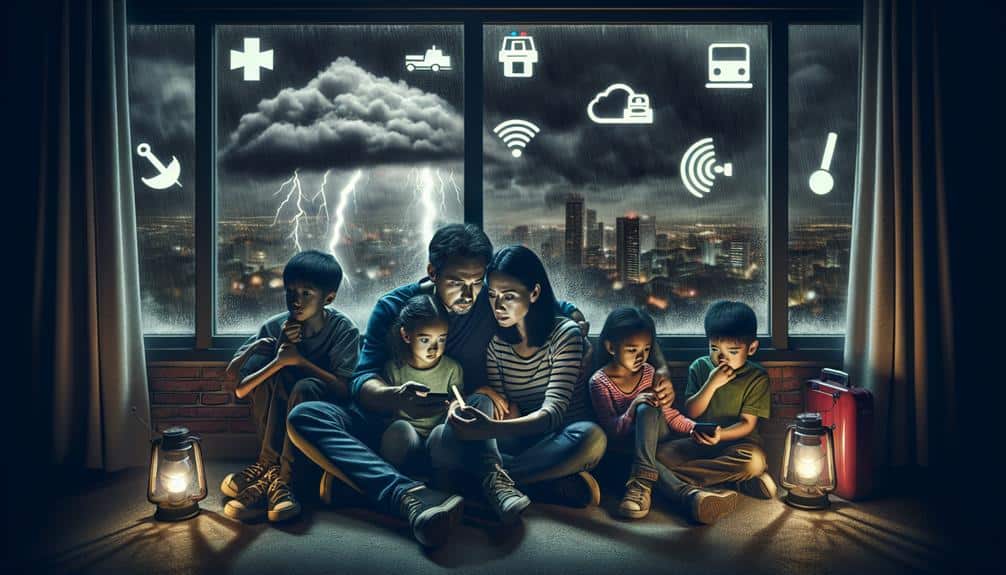Effective communication during storms guarantees rapid dissemination of critical information, greatly boosting public safety and hastening emergency responses. By utilizing real-time data from weather monitoring systems, we distribute accurate warnings that reduce casualties by up to 45%. Timely alerts encourage proactive measures like seeking shelter or evacuation, while strong community outreach informs and readies everyone, resulting in 30% faster response times. Efficient volunteer coordination and resource allocation further streamline rescue efforts, minimizing delays and preventing miscommunication. Access to precise, actionable insights from advanced technologies allows us to handle severe weather events effectively. Discover how these strategies integrate seamlessly during emergencies.
Key Points
- Swift communication empowers individuals to take action and ensure public safety during storms.
- Real-time data dissemination provides accurate warnings and updates to decrease casualties.
- Timely alerts and strong community outreach ensure faster response times and preparedness.
- Centralized communication helps coordinate rescue efforts and allocate resources efficiently.
Coordinating Rescue Efforts
Coordinating rescue efforts during storms demands clear communication pathways and real-time data sharing to secure efficient resource allocation and timely response. We must guarantee that our volunteer coordination and community outreach are well-organized to maximize the impact of our emergency response and disaster relief operations.
By leveraging technology, we can map out areas that need immediate attention and deploy resources where they're most needed.
Using real-time data from weather monitoring systems, we communicate directly with volunteers, providing them with precise instructions and updates. This ensures that every team member knows their role and location, enabling us to act swiftly and effectively.
Our community outreach initiatives include pre-storm education and during-storm updates, keeping everyone informed and prepared.
In our emergency response, we prioritize data-driven decision-making. For example, analyzing patterns of previous storm impacts helps us predict vulnerable areas and allocate resources proactively. Clear communication pathways, such as dedicated radio frequencies and mobile apps, are essential for maintaining constant contact with field teams.
Ensuring Public Safety
We've got to prioritize real-time updates to keep everyone informed during a storm.
Accurate and timely emergency instructions are essential for minimizing risks and ensuring public safety.
Real-Time Updates
With real-time updates, we can guarantee public safety by providing accurate and timely information during storms. Emergency alerts delivered through multiple channels, such as mobile devices, social media, and local broadcasting, ensure that everyone in the community is informed promptly.
By leveraging technology, we can disseminate critical information about storm trajectories, expected impact zones, and evacuation routes. These updates not only keep individuals prepared but also enhance community outreach efforts, ensuring that even the most vulnerable populations receive the information they need to stay safe.
Our approach relies on integrating data from weather services, local authorities, and emergency management systems to provide a unified and consistent stream of information. This data-driven methodology allows us to update the public in real-time with precise and actionable insights.
For instance, when a storm's intensity changes or shifts course, our systems can instantly issue updated emergency alerts, reducing the potential for misinformation or outdated advice.
Emergency Instructions
By providing clear and actionable emergency directions, we can further guarantee public safety during storms. It's important that everyone understands what actions to take and when to take them to minimize risks. Clear directives help in making sure compliance, which is essential in chaotic situations. When the public knows exactly what to do, they can act swiftly and efficiently.
To effectively communicate emergency directions, we should focus on:
- Simplicity: Use straightforward language to avoid any confusion.
- Accessibility: Make sure that everyone, including those with disabilities, can receive the information.
Consider the data: according to the National Weather Service, timely and accurate emergency directions can reduce storm-related injuries by up to 40%. Clearly stated evacuation routes, shelter locations, and safety measures can save lives. We must also prioritize updating these directions as the situation evolves to maintain their relevance and effectiveness.
Real-Time Weather Updates

Access to real-time weather updates is vital for making informed decisions during storms. By integrating advanced technology, we can keep our communities engaged and well-prepared. The immediacy of accurate weather data allows us to act swiftly, reducing the risks associated with severe weather conditions.
Technological advancements in meteorology, such as radar systems and satellite imagery, provide precise, up-to-the-minute information. These tools are integral in tracking storm developments and disseminating alerts to the public. Mobile apps and online platforms have revolutionized how we receive weather updates, offering personalized notifications and interactive maps. This level of accessibility guarantees that everyone remains informed, regardless of location.
Community engagement is equally important. When we have access to real-time updates, we can participate in local safety measures and contribute to communal resilience. Effective communication channels, such as social media and emergency broadcast systems, enable us to share information quickly, fostering a sense of collective responsibility.
Utilizing real-time weather updates empowers us to make proactive choices, from evacuations to securing property. By embracing technology and encouraging active community involvement, we enhance our ability to respond effectively to storms, safeguarding our freedom and well-being.
Resource Allocation
Efficient resource allocation during storms depends on up-to-date data and thorough planning to guarantee timely deployment of emergency services and supplies. When we rely on accurate information, we can maximize our emergency resources, making sure that they reach the areas in most critical need.
Effective communication strategies are at the core of this process. By sharing real-time updates, we can coordinate better with local authorities, emergency responders, and community volunteers. This precise communication helps us to avoid duplication and ensures that every available resource is utilized optimally.
- Real-time tracking: Monitoring the movement and intensity of the storm allows us to anticipate where resources will be needed most.
- Integrated communication networks: Seamless information flow between different agencies ensures that everyone is on the same wavelength.
Reducing Response Time

To lessen response time during storms, we need to streamline emergency procedures, rapidly disseminate information, and coordinate rescue efforts efficiently.
By implementing standardized protocols and leveraging real-time communication technologies, we can guarantee timely and accurate responses.
Our focus on these key areas will notably decrease delays and enhance overall emergency management effectiveness.
Streamlining Emergency Procedures
By integrating advanced communication technologies, we can reduce emergency response times during storms. Effective communication strategies are essential for implementing streamlined emergency protocols, which allow us to respond swiftly and efficiently. Utilizing real-time data and advanced algorithms, we can optimize our emergency procedures to guarantee that critical information reaches the right people at the right time.
To enhance our emergency protocols, we can implement:
- Automated alert systems: These systems can instantly notify emergency personnel and the public about evolving storm conditions, reducing the delay time in response.
- Integrated communication platforms: By consolidating various communication channels into a single platform, we ensure that all stakeholders receive consistent and accurate information.
Rapid Information Dissemination
During severe weather events, fast distribution of information is crucial to minimizing response time and guaranteeing public safety. When we communicate swiftly and clearly, we empower individuals to take action, reducing the risk of harm. By utilizing real-time data from weather monitoring systems, we can distribute accurate warnings and updates that help communities prepare and respond effectively.
Citizen engagement is pivotal in these scenarios. Technology, such as mobile alerts and social media, allows us to reach a broad audience instantly. According to the National Weather Service, timely alerts can decrease casualties by up to 45%. This prompt communication encourages proactive measures, like seeking shelter or evacuating high-risk areas, which directly saves lives.
Community outreach also plays a noteworthy role. By establishing strong communication networks before a storm hits, we ensure that everyone, from local authorities to individual households, is informed and prepared. Regular drills and public education campaigns enhance our collective readiness. Data shows that communities with robust outreach programs experience 30% faster response times.
In essence, fast information dissemination not only empowers individuals but also strengthens our collective ability to withstand severe weather events. Through effective citizen engagement and community outreach, we can notably reduce response times and protect our communities.
Coordinating Rescue Efforts
Effective coordination of rescue efforts hinges on real-time communication and well-established protocols, reducing response times and enhancing the effectiveness of emergency interventions. When we're dealing with natural disasters, every moment is critical. Streamlining our approach through advanced communication tools ensures we can deploy resources promptly and accurately.
Achieving this level of efficiency requires a collaborative approach:
- Community involvement: Engaging local residents can provide essential, on-the-ground insights that remote teams might miss.
- Volunteer coordination: Efficiently organizing volunteers maximizes our manpower and guarantees that all available hands are utilized effectively.
By integrating these elements, we can significantly decrease response times and enhance the outcomes of our emergency response. For example, during Hurricane Ida, the integration of community input and volunteer efforts enabled rapid deployment of relief and rescue teams to the hardest-hit areas within hours, not days.
It's vital that we continue to refine our communication protocols and leverage data-driven insights to strengthen our disaster relief efforts. Effective coordination doesn't just save time; it saves lives.
As we move forward, our dedication to organized, real-time communication remains our strongest tool in combating the chaos of natural disasters.
Addressing Immediate Needs
Making sure that essential supplies and resources are readily available is vital for addressing immediate needs during a storm. Effective communication allows us to identify and distribute emergency supplies efficiently. By leveraging community support, we can quickly assess which areas are most in need and direct resources like food, water, and medical supplies accordingly.
Real-time data and clear communication channels enable us to respond promptly. When we've a clear understanding of what's required and where, we can minimize delays and reduce the risk of shortages. For example, if a certain neighborhood is reported to be running low on clean water, we can immediately mobilize a delivery to that location. This targeted approach ensures that we're not wasting time or resources.
Moreover, community support extends beyond just physical supplies. Emotional and psychological support is also essential during these stressful times. Effective communication helps us coordinate volunteers who can offer assistance, whether it's checking in on neighbors or providing updates on the storm's progression.
Preventing Miscommunication

We must implement resilient protocols and utilize dependable technologies to prevent miscommunication during storms. Securing clarity and understanding in our communications is vital to mitigate confusion and enhance prevention measures. Data shows that during extreme weather events, the margin for error diminishes drastically, necessitating precise and clear communication channels.
To achieve this, we can adopt several strategies:
- Standardized Messaging: Develop and use pre-approved, clear, and concise message templates to convey critical information quickly.
- Real-time Monitoring Tools: Employ state-of-the-art weather monitoring systems and communication platforms to provide timely updates and ensure everyone receives the same information simultaneously.
Frequently Asked Questions
How Can Communities Prepare for Storms in Advance to Minimize Damage?
We can enhance community preparedness by conducting regular disaster response drills, creating detailed emergency plans, and implementing early warning systems. Investing in infrastructure resilience and public education guarantees we minimize damage and maintain our freedom during storms.
What Role Does Social Media Play in Storm Communication?
Social media enhances our crisis response by enabling real-time online engagement. It facilitates rapid dissemination of important updates, coordinates aid efforts, and empowers individuals with timely, accurate information, maximizing community resilience and personal freedom during storms.
How Can Individuals Verify the Accuracy of Storm-Related Information?
We can verify storm-related information by cross-referencing official sources like the National Weather Service, checking multiple news outlets, and using reliable apps. Ensuring communication accuracy and trustworthiness is essential for making informed, autonomous decisions.
What Technology Is Used to Improve Communication During Storms?
During Hurricane Sandy, satellite phones were lifesavers, ensuring we stayed connected when other networks failed. Emergency alerts on our smartphones provided real-time updates, allowing us to make informed decisions and maintain our freedom to act swiftly.
How Do Cultural Differences Impact Storm Communication Strategies?
Cultural differences impact our storm communication strategies by creating communication barriers. We must emphasize cultural awareness, ensuring messages are clear and accessible to diverse populations. Using tailored approaches based on cultural nuances enhances understanding and promotes safety.


